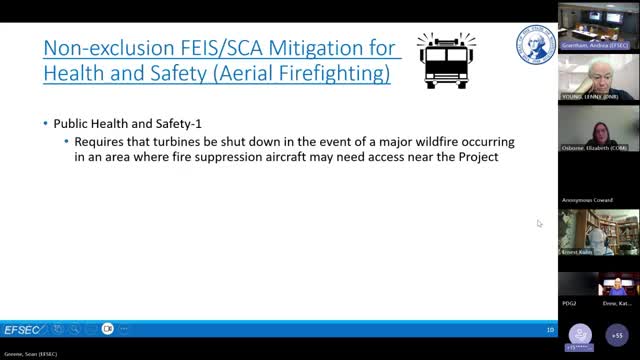Council considers turbine safety measures amid wildfire risks
July 18, 2024 | Energy Facility Site Evaluation Council, Governor's Office - Boards & Commissions, Executive, Washington

This article was created by AI summarizing key points discussed. AI makes mistakes, so for full details and context, please refer to the video of the full meeting. Please report any errors so we can fix them. Report an error »

In a recent government meeting, officials discussed critical measures regarding public health and safety in relation to aerial firefighting and the placement of wind turbines. The conversation centered on two proposed options aimed at mitigating risks associated with historic wildfires in the project area, which has seen significant fire activity since 2000.
The first option suggests eliminating any proposed turbines within the perimeter of historic wildfires, while the second option recommends a 0.25-mile buffer zone around these perimeters. This buffer aligns with guidance from the Department of Natural Resources (DNR), which advises a quarter-mile standoff for aerial firefighting operations. Implementing the first option would remove approximately 1% of the proposed turbines, whereas the second option could exclude between 3% to 5%.
A detailed map presented during the meeting illustrated the locations of historic fires and the proposed turbine sites. The discussion highlighted the importance of considering topography and vegetation in assessing fire risk, as these factors can influence the spread of fires in the area, particularly in regions like Weber Canyon, where prevailing winds exacerbate fire conditions.
Participants acknowledged that while using historic fire data is a common practice for evaluating future fire risks, it does not guarantee that future fires will occur in the same locations. Concerns were raised about the potential hazards that turbines pose to aerial firefighting operations, emphasizing the need for careful planning and consideration of safety measures.
Overall, the meeting underscored the delicate balance between advancing renewable energy projects and ensuring public safety in fire-prone areas, with officials leaning towards adopting the more cautious second option to enhance safety for aerial firefighting efforts.
The first option suggests eliminating any proposed turbines within the perimeter of historic wildfires, while the second option recommends a 0.25-mile buffer zone around these perimeters. This buffer aligns with guidance from the Department of Natural Resources (DNR), which advises a quarter-mile standoff for aerial firefighting operations. Implementing the first option would remove approximately 1% of the proposed turbines, whereas the second option could exclude between 3% to 5%.
A detailed map presented during the meeting illustrated the locations of historic fires and the proposed turbine sites. The discussion highlighted the importance of considering topography and vegetation in assessing fire risk, as these factors can influence the spread of fires in the area, particularly in regions like Weber Canyon, where prevailing winds exacerbate fire conditions.
Participants acknowledged that while using historic fire data is a common practice for evaluating future fire risks, it does not guarantee that future fires will occur in the same locations. Concerns were raised about the potential hazards that turbines pose to aerial firefighting operations, emphasizing the need for careful planning and consideration of safety measures.
Overall, the meeting underscored the delicate balance between advancing renewable energy projects and ensuring public safety in fire-prone areas, with officials leaning towards adopting the more cautious second option to enhance safety for aerial firefighting efforts.
View full meeting
This article is based on a recent meeting—watch the full video and explore the complete transcript for deeper insights into the discussion.
View full meeting
